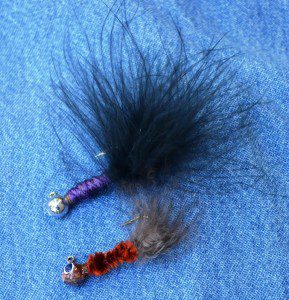Wilderness and Emergency Survival Kits
No collection of tools can help if you don't know how to use them! Here are some suggestions for making survival kits that might give you a fighting chance to survive during a wilderness and/or urban emergency! And here's a thought from C.S. Lewis about survival gear: "The things that make survival worth having are not to be rated below the things that enable us to survive."
Tuesday, December 2, 2014
Wednesday, January 30, 2013
Make this effective firemaking kit: A special section from the Bend Bulletin
The ability to build a survival fire for warming, light or signalling can be critical during a wilderness emergency. Here are some proven techniques from the Bulletin Winter Survival Guide.
by Leon Pantenburg
In October, 2007, The Bend (OR) Bulletin published a special winter survival guide for Central Oregon, which I researched and wrote.
There was a real need for practical survival information at the time. In November, 2006, veteran snowmobiler Roger Rouse, 53, of Bend, died of hypothermia in Deschutes National Forest, about 10 miles west of Bend. He and his son had intended to only be out for a morning ride when a fierce snowstorm overwhelmed them. (To read the complete story, click here.)
Less than a month later, in December 2006, Californian James Kim, 35, died in the Rogue River Wilderness after leaving his wife and children to get help. The family car was stuck in snow on a remote road. (To see Larry King’s coverage of the Kim tragedy, click here.)
Shortly after the Kim tragedy, I was asked to research, write and put together a practical winter survival guide. Long story short, the next fall, the Bulletin published the guide. It received some awards and a lot of attention.
The Bulletin is publishing the three-part series as a public service, and this week's section features emergency firemaking. Check out Part Two.
For more survival gear information, click on making your own survival kits!
by Leon Pantenburg
 |
| Click to buy survival kits |
In October, 2007, The Bend (OR) Bulletin published a special winter survival guide for Central Oregon, which I researched and wrote.
 |
| Being able to make a quick campfire under survival conditions can save your life. (Pantenburg photo) |
There was a real need for practical survival information at the time. In November, 2006, veteran snowmobiler Roger Rouse, 53, of Bend, died of hypothermia in Deschutes National Forest, about 10 miles west of Bend. He and his son had intended to only be out for a morning ride when a fierce snowstorm overwhelmed them. (To read the complete story, click here.)
Less than a month later, in December 2006, Californian James Kim, 35, died in the Rogue River Wilderness after leaving his wife and children to get help. The family car was stuck in snow on a remote road. (To see Larry King’s coverage of the Kim tragedy, click here.)
Shortly after the Kim tragedy, I was asked to research, write and put together a practical winter survival guide. Long story short, the next fall, the Bulletin published the guide. It received some awards and a lot of attention.
The Bulletin is publishing the three-part series as a public service, and this week's section features emergency firemaking. Check out Part Two.
For more survival gear information, click on making your own survival kits!
Use different levels of survival kits: A special section from the Bend Bulletin
Nationwide attention was brought to winter survival because of a stalled vehicle tragedy in 2006.
by Leon Pantenburg
The genesis of SurvivalCommonSense.com began after two fatalities in Central Oregon in late 2006.
In November, veteran snowmobiler Roger Rouse, 53, of Bend, died of hypothermia in Deschutes National Forest, about 10 miles west of Bend. He and his son had intended to only be out for a morning ride when a fierce snowstorm overwhelmed them. (To read the complete story, click here.)
Less than a month later, in December 2006, Californian James Kim, 35, died in the Rogue River Wilderness after leaving his wife and children to get help. The family car was stuck in snow on a remote road. (To see Larry King’s coverage of the Kim tragedy, click here.)
Shortly after the Kim tragedy, the editor of The Bulletin in Bend, Oregon, asked me to put together a practical winter survival guide.
“Talk to (Deschutes County) Search and Rescue, find out what the trends are, and what gear people need to take with them,” the editor said. “Then, come up with a practical survival kit for our readers, based on the experts’ recommendations. This is an investigative assignment. Check out all sources, and test everything.”
The survival guide was received very well, and got a lot of attention. At that point, I figured out that there needed to be more practical survival information available, and I started the SurvivalCommonSense website. Now, more than a million views later, we're pleased to continue our common sense approach to wilderness survival.
As a public service, The Bulletin is reprinting the winter survival series.
Thank you, Bulletin! Here is the original survival guide.
For more information, click on making your own survival kits!
by Leon Pantenburg
The genesis of SurvivalCommonSense.com began after two fatalities in Central Oregon in late 2006.
 |
| Click here to buy survival kits |
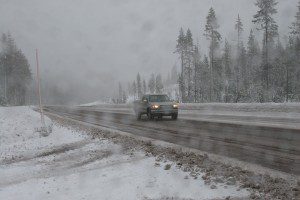 |
| A survival situation can start with a vehicle sliding off the road (Pantenburg photo) |
In November, veteran snowmobiler Roger Rouse, 53, of Bend, died of hypothermia in Deschutes National Forest, about 10 miles west of Bend. He and his son had intended to only be out for a morning ride when a fierce snowstorm overwhelmed them. (To read the complete story, click here.)
Less than a month later, in December 2006, Californian James Kim, 35, died in the Rogue River Wilderness after leaving his wife and children to get help. The family car was stuck in snow on a remote road. (To see Larry King’s coverage of the Kim tragedy, click here.)
Shortly after the Kim tragedy, the editor of The Bulletin in Bend, Oregon, asked me to put together a practical winter survival guide.
“Talk to (Deschutes County) Search and Rescue, find out what the trends are, and what gear people need to take with them,” the editor said. “Then, come up with a practical survival kit for our readers, based on the experts’ recommendations. This is an investigative assignment. Check out all sources, and test everything.”
The survival guide was received very well, and got a lot of attention. At that point, I figured out that there needed to be more practical survival information available, and I started the SurvivalCommonSense website. Now, more than a million views later, we're pleased to continue our common sense approach to wilderness survival.
As a public service, The Bulletin is reprinting the winter survival series.
Thank you, Bulletin! Here is the original survival guide.
For more information, click on making your own survival kits!
Tuesday, January 22, 2013
Eight reasons why you need notebook in your emergency gear
Part of my everyday carry gear is a notebook and a pen or pencil. Here is why these are important.
by Leon Pantenburg
For decades, I have carried a pencil or pen and small pocket notebook as part of my everyday carry gear.
As a working journalist, these are tools of the trade, and this is a no-brainer. Part of my job is gathering information and interviewing sources. I always have a larger notebook in my briefcase or car and a pen and pencil.
But the small, pocket-sized notebook that fits in my hip pocket gets used way beyond what you'd imagine. In my urban lifestyle, that's the notebook I use constantly to write messages, grocery lists, notes to put under windshield wiper blades, and reminders of things to do.
But the most important aspect is convenience. If the notebook is easy to carry, you won't leave it behind.
You might want to invest in a notebook with waterproof paper as some foresters or emergency personnel use. But whatever size you carry in the backcountry, make sure your notebook is carried in a plastic bag, or something that keeps it dry in the rain or after a dunking in a creek.
And no electronic gee-wizardry, please. Anything powered by batteries is as reliable as the power source. Cold weather can kill batteries in your whatever-phone, leaving you with a paperweight.
In a survival kit, your notebook can be more important than you could imagine. Here are some uses:
Write a treatment note: Suppose you have to administer first aid to someone, and the victim must be passed on to a Search And Rescue or Emergency Medical Technician. Medical personnel will really appreciate a brief note, documenting what treatment you have already done. Use the five Ws: Who, What, Where, Why and When to explain what treatment was given and any observations. An effective note can save precious time.
Leave a note in your car: Always leave a note with someone, again elaborating on the five Ws, when you take off on an adventure. This note should be left at home with a responsible adult. At the trailhead, if there are any changes in plan, a note should be left on the dashboard, or under the windshield wiper, where it can be easily read. This can save Search and Rescue teams countless hours of searching if you don't return as planned.
Directions you took: If you get in a complicated or confusing area, write notes to yourself about which turns you took and what landmarks were noticed. Later, if you're returning in the dark or the weather gets bad, you don't have to wonder which way to go. If you are stressed or under duress of some sort, there is a propensity to forget directions. A clear note will help.
Notes on the trail conditions: It is helpful to record trail conditions in some cases, so on the return trip you don't forget about an icy spot or a hazard on the trail.
Trace a map: On one snowshoe trip, I noticed a new trail on the kiosk of a warming hut. It was easy to trace the route on a piece of paper, along with GPS coordinates.
Photo specifics: As a photographer, I'm always interested in what works under challenging situations. If you're tackling a particularly tricky shot, write down what you did so you don't have to reinvent the wheel the next time. It's also nice to record GPS coordinates of a particularly nice area or landscape.
Tic Tac Toe: Or other games. A danger in the wilderness is getting bored while waiting to be rescued or for the weather to clear. I take along a deck of cards, and a note book allows keeping score. Anything that keeps your mind occupied in an emergency or disaster situation is a survival tool.
Make a plan: Every survival situation should have a plan of action for getting you out of it. Write down your plans and how you intend to implement them. That way, under stress, you won't forget to do something important.
That's eight uses for a notebook, and there are a lot more if you use your imagination.

by Leon Pantenburg
For decades, I have carried a pencil or pen and small pocket notebook as part of my everyday carry gear.
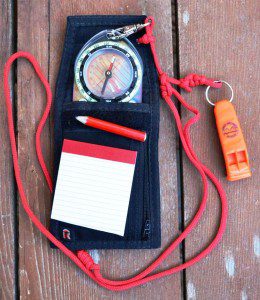 |
| I always carry a pencil and notebook in my compass setup. (Pantenburg photos) |
But the small, pocket-sized notebook that fits in my hip pocket gets used way beyond what you'd imagine. In my urban lifestyle, that's the notebook I use constantly to write messages, grocery lists, notes to put under windshield wiper blades, and reminders of things to do.
But the most important aspect is convenience. If the notebook is easy to carry, you won't leave it behind.
You might want to invest in a notebook with waterproof paper as some foresters or emergency personnel use. But whatever size you carry in the backcountry, make sure your notebook is carried in a plastic bag, or something that keeps it dry in the rain or after a dunking in a creek.
And no electronic gee-wizardry, please. Anything powered by batteries is as reliable as the power source. Cold weather can kill batteries in your whatever-phone, leaving you with a paperweight.
In a survival kit, your notebook can be more important than you could imagine. Here are some uses:
Write a treatment note: Suppose you have to administer first aid to someone, and the victim must be passed on to a Search And Rescue or Emergency Medical Technician. Medical personnel will really appreciate a brief note, documenting what treatment you have already done. Use the five Ws: Who, What, Where, Why and When to explain what treatment was given and any observations. An effective note can save precious time.
 |
| This 30-year-old note shows my canoeing partner, John Nerness, finished next to last, while I took second place in this Pitch game. |
Leave a note in your car: Always leave a note with someone, again elaborating on the five Ws, when you take off on an adventure. This note should be left at home with a responsible adult. At the trailhead, if there are any changes in plan, a note should be left on the dashboard, or under the windshield wiper, where it can be easily read. This can save Search and Rescue teams countless hours of searching if you don't return as planned.
Directions you took: If you get in a complicated or confusing area, write notes to yourself about which turns you took and what landmarks were noticed. Later, if you're returning in the dark or the weather gets bad, you don't have to wonder which way to go. If you are stressed or under duress of some sort, there is a propensity to forget directions. A clear note will help.
Notes on the trail conditions: It is helpful to record trail conditions in some cases, so on the return trip you don't forget about an icy spot or a hazard on the trail.
Trace a map: On one snowshoe trip, I noticed a new trail on the kiosk of a warming hut. It was easy to trace the route on a piece of paper, along with GPS coordinates.
Photo specifics: As a photographer, I'm always interested in what works under challenging situations. If you're tackling a particularly tricky shot, write down what you did so you don't have to reinvent the wheel the next time. It's also nice to record GPS coordinates of a particularly nice area or landscape.
Tic Tac Toe: Or other games. A danger in the wilderness is getting bored while waiting to be rescued or for the weather to clear. I take along a deck of cards, and a note book allows keeping score. Anything that keeps your mind occupied in an emergency or disaster situation is a survival tool.
Make a plan: Every survival situation should have a plan of action for getting you out of it. Write down your plans and how you intend to implement them. That way, under stress, you won't forget to do something important.
That's eight uses for a notebook, and there are a lot more if you use your imagination.
Sunday, September 9, 2012
Survival gear review: The Platypus collapsible water bottle
Carrying enough water to prevent dehydration should be a no-brainer. But suppose you don't want the bulk and weight of extra containers? One option might be the Platypus collapsible water bottle.
by Leon Pantenburg
Many survival manuals devote space to improvising water containers. And if you haven't planned ahead, or get into an unexpected situation, that may be necessary.
But one of the easiest way to carry extra water storage bottles is to get a collapsible Platypus. These range in size from a few ounces to multi-gallon sizes.
I've been carrying some variation of the Platypus bottle for several years. Here are some aspects I like about the collapsible containers:
Price: A Platypus will set you back about $12 for a 1.2 liter bottle. That's cheap for a water bottle that can last years with reasonable care.
Durability: I've been using a couple of Platypus bottles for several years, and they are holding up fine. In my case, a Platypus is generally carried rolled up as a backup in desert hiking. If there is a need to gather extra water, it will work well. You can break anything, of couse, but as long as you take reasonable care not to puncture it, the bottle should have an infinite lifespan.
Portability: With a collapsible, you can push the air out, and the bottle takes up only the space that the water needs. This
means you can pack it in oddly-shaped empty places in your pack. A Platypus also has a flat bottom, so it will stand by itself.
Convenience: You can carry a rolled-up Platypus in a brief case or purse, and breeze right through an airport security station. Once past the Homeland Security people, you can fill the Platypus from a water fountain and carry water with you. I can carry a couple rolled-up Platypus bottles (weight: about an ounce or so) in my daypack or briefcase and never know they're there.
A Platypus is one of those unique survival items you'll never know you needed until you get one. A Platypus is a sound investment for your urban and wilderness survival kits.
by Leon Pantenburg
 |
| Click here to buy survival kits |
Many survival manuals devote space to improvising water containers. And if you haven't planned ahead, or get into an unexpected situation, that may be necessary.
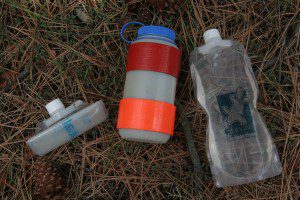 |
| This combination of water bottles works well. The rigid Nalgene in the middle is used for drinking and the Paltypus soft bottle are used to carry extra water. (Pantenburg photo |
But one of the easiest way to carry extra water storage bottles is to get a collapsible Platypus. These range in size from a few ounces to multi-gallon sizes.
I've been carrying some variation of the Platypus bottle for several years. Here are some aspects I like about the collapsible containers:
Price: A Platypus will set you back about $12 for a 1.2 liter bottle. That's cheap for a water bottle that can last years with reasonable care.
Durability: I've been using a couple of Platypus bottles for several years, and they are holding up fine. In my case, a Platypus is generally carried rolled up as a backup in desert hiking. If there is a need to gather extra water, it will work well. You can break anything, of couse, but as long as you take reasonable care not to puncture it, the bottle should have an infinite lifespan.
Portability: With a collapsible, you can push the air out, and the bottle takes up only the space that the water needs. This
means you can pack it in oddly-shaped empty places in your pack. A Platypus also has a flat bottom, so it will stand by itself.
Convenience: You can carry a rolled-up Platypus in a brief case or purse, and breeze right through an airport security station. Once past the Homeland Security people, you can fill the Platypus from a water fountain and carry water with you. I can carry a couple rolled-up Platypus bottles (weight: about an ounce or so) in my daypack or briefcase and never know they're there.
A Platypus is one of those unique survival items you'll never know you needed until you get one. A Platypus is a sound investment for your urban and wilderness survival kits.
The leadhead jig: The do-it-all survival fishing lure?
Is there a do-it-all lure for survival fishing? My money is on the plain lead head jig. Here's why.
by Leon Pantenburg
After my first week on the Mississippi River, I sent three fishing rods and a large tackle box home. After seven days of fishing and catching many walleye, smallmouth bass, northern pike, crappie and bluegills, I didn't anticipate needing anything but a medium-action, fast-tip, seven-foot spinning rod, a Mitchell 300 reel
with six-pound line and a box of spinners and leadhead jigs.
This selection served me well the rest of the way down the 2,500 miles of the river. I never went hungry because I couldn't catch a fish and my go-to lure was a 1/8-ounce jig, tipped with a three-inch yellow Mr. Twister. (To read the story, click on my end-to-end Mississippi River canoe voyage.)
When putting together a survival kit, you must to carefully weigh the value of the components. A common question is about fishing lures: Is there one lure that can catch everything?
First, though, remember that survival fishing is not sport fishing. If you must catch fish to survive, use the most effective method available, legal or not.
Hook and line sport fishing techniques may not be particularly effective in a survival situation. In fact, it may be a waste of really valuable time if you're fishing when a better choice might be to gather firewood, improve a shelter, or set up signals.
You also need to figure out the return on your calorie investment. If you must expend 300 calories to catch a fish that can only supply 100 calories, you're going to end up with an energy deficit.
So the choice of the best survival lure depends on the situation, location and water conditions. Talk to several fisherpeople and you'll probably get that many opinions.
My best all-around nomination is for the leadhead jig, and here's why:
Inexpensive: The jig is nothing more than a hook with a gob of lead near the eyelet. I pour my own, ranging in weight
from 1/32-ounce to 1/4-ounce, in several styles. Several years ago, the guys in the print shop at the newspaper gave me about 20 pounds of old linetype lead. My jigs cost the price of the hooks, and whatever electricity it takes to run my melting pot.
You can buy bulk leadheads at any sporting goods store, and the bodies are so inexpensive, you can stock up on different colors, styles and sizes.
Versatile: I tip jigs with virtually anything, from plastic twister tail grub bodies, to hair and feathers. Since I hunt, I have a lifetime supply of deer, elk and squirrel tails, and the feathers from a variety of game birds. Depending on the species of fish and circumstances, I can make just about any type of jig necessary. Part of the fun of fishing is catching something on a homemade lure!
Effectiveness: The jig is designed to mimic a minnow, or represent some other food source. Sometimes, a properly-fished jig will cause a reflexive strike for a game fish. While I have a tackle box full of various lures, I generally start out with a jig, and seldom have reason to switch.
Color: Start out with a basic selection of black, white and chartreuse, and those colors will probably do the job. My favorite color on the Mississippi River was yellow. My top producer color on Oregon's John Day River is motor oil or brown. Black is always a contender. Experiment in your area, and you'll be able to dial in your color preferences.
Fishing technique for a jig can depend on the circumstances. The most effective method, IMHO, is to cast the lure out, and bounce it off the bottom. You will lose a lot of jigs like this, but if you aren't hitting snags or rocks, you aren't prospecting where the fish are.
Another method is a steady retrieve, with periodic twitches. A favorite panfishing method that also works well for steelhead trout is to attach a jig a few feet under a bobber or float.
Like any survival technique, the more you practice, the more effective you will be. And to be required to practice fishing...well, worse things can happen!
by Leon Pantenburg
 |
| Click here to buy survival kits |
After my first week on the Mississippi River, I sent three fishing rods and a large tackle box home. After seven days of fishing and catching many walleye, smallmouth bass, northern pike, crappie and bluegills, I didn't anticipate needing anything but a medium-action, fast-tip, seven-foot spinning rod, a Mitchell 300 reel
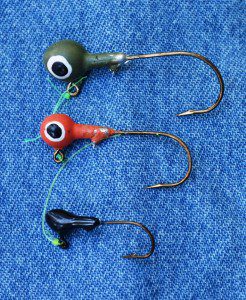 |
| The basis of a very effective group of survival fishing lures is the simple, leadhead jig. From top is a quarter, eighth and sixteenth ounce jig (Pantenburg photos) |
This selection served me well the rest of the way down the 2,500 miles of the river. I never went hungry because I couldn't catch a fish and my go-to lure was a 1/8-ounce jig, tipped with a three-inch yellow Mr. Twister. (To read the story, click on my end-to-end Mississippi River canoe voyage.)
When putting together a survival kit, you must to carefully weigh the value of the components. A common question is about fishing lures: Is there one lure that can catch everything?
First, though, remember that survival fishing is not sport fishing. If you must catch fish to survive, use the most effective method available, legal or not.
Hook and line sport fishing techniques may not be particularly effective in a survival situation. In fact, it may be a waste of really valuable time if you're fishing when a better choice might be to gather firewood, improve a shelter, or set up signals.
You also need to figure out the return on your calorie investment. If you must expend 300 calories to catch a fish that can only supply 100 calories, you're going to end up with an energy deficit.
So the choice of the best survival lure depends on the situation, location and water conditions. Talk to several fisherpeople and you'll probably get that many opinions.
My best all-around nomination is for the leadhead jig, and here's why:
Inexpensive: The jig is nothing more than a hook with a gob of lead near the eyelet. I pour my own, ranging in weight
from 1/32-ounce to 1/4-ounce, in several styles. Several years ago, the guys in the print shop at the newspaper gave me about 20 pounds of old linetype lead. My jigs cost the price of the hooks, and whatever electricity it takes to run my melting pot.
You can buy bulk leadheads at any sporting goods store, and the bodies are so inexpensive, you can stock up on different colors, styles and sizes.
Versatile: I tip jigs with virtually anything, from plastic twister tail grub bodies, to hair and feathers. Since I hunt, I have a lifetime supply of deer, elk and squirrel tails, and the feathers from a variety of game birds. Depending on the species of fish and circumstances, I can make just about any type of jig necessary. Part of the fun of fishing is catching something on a homemade lure!
Effectiveness: The jig is designed to mimic a minnow, or represent some other food source. Sometimes, a properly-fished jig will cause a reflexive strike for a game fish. While I have a tackle box full of various lures, I generally start out with a jig, and seldom have reason to switch.
Color: Start out with a basic selection of black, white and chartreuse, and those colors will probably do the job. My favorite color on the Mississippi River was yellow. My top producer color on Oregon's John Day River is motor oil or brown. Black is always a contender. Experiment in your area, and you'll be able to dial in your color preferences.
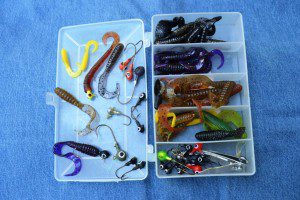 |
| This pocket-sized box holds all the lures I need for a day of smallmouth bass fishing on Oregon's John Day River. |
Another method is a steady retrieve, with periodic twitches. A favorite panfishing method that also works well for steelhead trout is to attach a jig a few feet under a bobber or float.
Like any survival technique, the more you practice, the more effective you will be. And to be required to practice fishing...well, worse things can happen!
Subscribe to:
Posts (Atom)

